so do I, christian!
Getting the leather to seat properly over the rounded surface can be a tricky task, but I was able to stretch leather over the bottom of a seax handle that had a domed bottom that was slightly rectangular. I used a similar groove as the one seen in your pommel to secure the leather with a piece of cord while working the wrinkles out of the leather. I think technically speaking the pommel shape and groove include all the component to ease the process of applying the leather. It would be interesting to know what, if anything, was placed inside of the grooves since that is where the two edges of the leather would come together. In my case I inserted a twisted wire and got a fairly clean look.
Very nice job on the hilt and the overall blade :) I've really enjoyed this thread and seeing your work!
 Attachment: 5.36 KB
Attachment: 5.36 KB
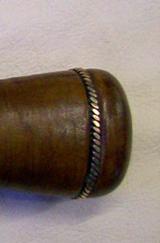
Very nice job on the hilt and the overall blade :) I've really enjoyed this thread and seeing your work!

| Michael Pikula wrote: |
| I think technically speaking the pommel shape and groove include all the component to ease the process of applying the leather. It would be interesting to know what, if anything, was placed inside of the grooves since that is where the two edges of the leather would come together. |
That is the question!! Could have been an iron ring, because the iron dissapeared in the Thorsberg-bog, same happened to the sword-blades there. So iron would be a reasonable possibility! Only the grooves could have survived of it....BUT: There are also such pommels without grooves but with similair rivets! ....and: you would in such cases see a speciality at the bottom of the brass pommeI-crown (don´t know the right word for it, the brass piece where the tang-end is peened over) or at the top of the pommel, where the iron ring must have been devided to let the tang go through. Same at the top of the guard and the bottom of the hilt. If not the wire had passed through the hilt-hole alongside the tang and surrounding the pommel to get back down alongside the tang to finally surround the guard to be finally fixed between the shoulders of the blade and the guard (which I think is possible). Nevertheless: I like it without leather also!
Maybe they used the leather of Auroch´s bollocks, applied it wet and bloody, put the wood with the bullock-cover in the oak-and-peat pit for a year and let it dry again..... no, just joking :)
But: I finished the scabbard today, will show images tomorrow evening together with the sword....
I think that leather cover may have been common, but I think not universal.
I also think that the grove was used for the two edges of leather to meet in a handy way and as a secure place to keep a cord while the glue and leather dried. As it has set, you do not really need something in the grove. The imprint of the cord will look like some of the press blech decorations you see i in those pommels and guards that are made in silver/bronze.
SOme hilts have those narrow strips of iron sheet metal fastened down with small tacks. They are another version of solution to this problem of keeping the leather in place and wrinkle free.
Some more experiments with reconstructions will give us more ideas, I´m sure!
I also think that the grove was used for the two edges of leather to meet in a handy way and as a secure place to keep a cord while the glue and leather dried. As it has set, you do not really need something in the grove. The imprint of the cord will look like some of the press blech decorations you see i in those pommels and guards that are made in silver/bronze.
SOme hilts have those narrow strips of iron sheet metal fastened down with small tacks. They are another version of solution to this problem of keeping the leather in place and wrinkle free.
Some more experiments with reconstructions will give us more ideas, I´m sure!
| Christian Böhling wrote: |
|
..... Maybe they used the leather of Auroch´s bollocks, applied it wet and bloody, put the wood with the bullock-cover in the oak-and-peat pit for a year and let it dry again..... no, just joking :) .... |
Christian, I have actually thought about this as well!
The "pouch" from bulls or he goats would fit the bill very well!
It was used for small bags, was it not?
Otherwise I´d put my money on gut leather, as raw hide, no tanning.
And, I am looking forward to seeing that sword complete with scabbard :-)
| Peter Johnsson wrote: | ||
Christian, I have actually thought about this as well! The "pouch" from bulls or he goats would fit the bill very well! |
To all TOUCHY boys and girls out there:
This is the reason why "normal" people call us mad, WE ARE NOT, WE ARE TOTALLY INSANE!!! :)
| Petr Florianek wrote: |
| Hello gentlemen!
I would like to replikate or craft item inspired by the find, which is now in Schleswik museum. Its not my usual interest period so i am little confused. Could you chime in and advice few things? 1) whats the dating, i assume 2nd century AD, but i dont know 2)what kind of blade? lenticular? diamond? welded edges? san mai? or just wrought? is it possible 3)Does the scabbard match? thanks in advance! |
...An interesting feature of this hilt is its grip, which is covered with free
bronze thread intricately braided (fig. 37) which is well worth noting since it is a form of gripcovering
which was popular in the late seventeenth century and the early eighteenth. We shall find,
too, that there are mediaeval monuments which show sword grips similarly treated, though with
what material the carved stone gives no clue. We have always assumed that the interlacing patterns
were formed by flat leather ribbons; maybe we were wrong. At Thorsbjerg 37 Roman coins were
found; the earliest of Nero, A.D. 60, and the latest of Septimus Severus, A.D. 194....
from the book: Arm and armor from Prehistory pag 110
a sword is very similar to Pompei (southern Italy) 24 agust 79 A.D. Vesuvius erupted.

Now the finished piece with scabbard. Don´t mind the bad quality of the pics, try to get some better next days. My camera seems to deform the image if I take photos from direct above, but believe me, the blade is straight and the shadows does not apprear on the surface of the blade :(. Seeing the pics, it looks like if the scabbard mouth was narrower than the scabbard itself: IT IS NOT! It is a very bad picture.....When I have my better camera I will visit the new owner to take good photos so that you can see it in the real appearance...
 Attachment: 99.91 KB
Attachment: 99.91 KB

Bronce parts showing all details of the original. Will make better pics next days...
 Attachment: 98.58 KB
Attachment: 98.58 KB

 Attachment: 112.1 KB
Attachment: 112.1 KB
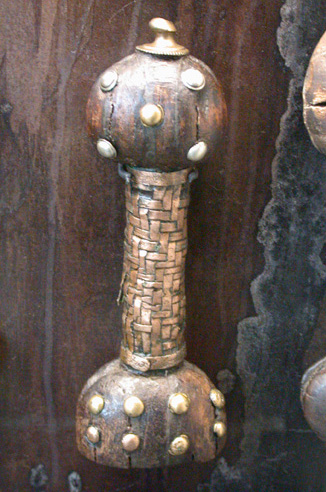
 Attachment: 52.12 KB
Attachment: 52.12 KB
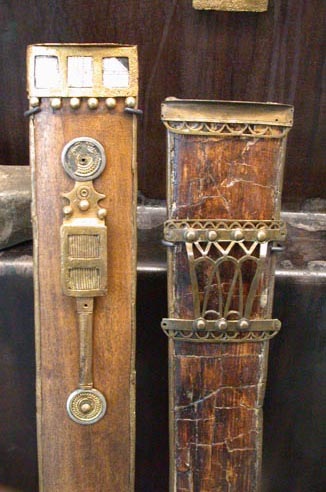
 Attachment: 102.52 KB
Attachment: 102.52 KB
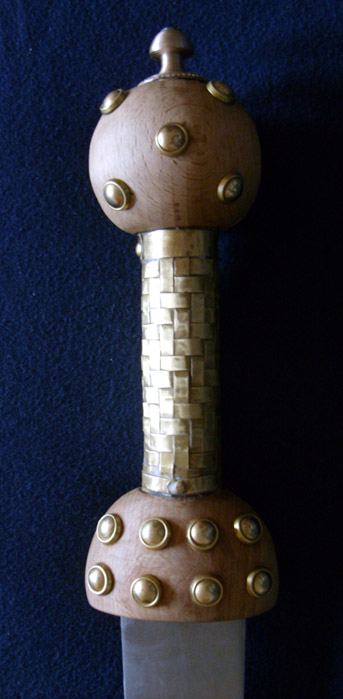
This pic shows the hilt before it was finished with bee´s wax, looks much better now.

Bronce parts showing all details of the original. Will make better pics next days...




This pic shows the hilt before it was finished with bee´s wax, looks much better now.
Last edited by Christian Böhling on Mon 01 Mar, 2010 6:55 am; edited 1 time in total
| Maurizio D'Angelo wrote: |
|
...An interesting feature of this hilt is its grip, which is covered with free bronze thread intricately braided (fig. 37) which is well worth noting since it is a form of gripcovering which was popular in the late seventeenth century and the early eighteenth. We shall find, too, that there are mediaeval monuments which show sword grips similarly treated, though with what material the carved stone gives no clue. We have always assumed that the interlacing patterns were formed by flat leather ribbons; maybe we were wrong. At Thorsbjerg 37 Roman coins were found; the earliest of Nero, A.D. 60, and the latest of Septimus Severus, A.D. 194.... from the book: Arm and armor from Prehistory pag 110 a sword is very similar to Pompei (southern Italy) 24 agust 79 A.D. Vesuvius erupted. |
Have a look at the whole thread in "Iron Age Crafts" you can see a small making of the woven grip... Among the bog finds of southern Scandinavia and northern Germany this woven grip is unique. I wondered if such a brass weaving would be uncomfortable in hand but it is not! The brass strips do not cut in the skin if woven round without a seam. I must say that it feels really good in hand, and not "slippy". It gives you a save feeling while handling the sword...
Cheers
Chris
I have to correct my information on the Spatha of Pompeii.
The error comes from here: (same book)
"There is also the hilt of a Roman sword, similar to one found in Pompeii and another (in the British
Museum) found in England. An interesting feature of this hilt is its grip, Which is covered with free
bronze intricately braided thread (Fig. 37) which is well worth noting since it is a form of gripcovering
which was popular in the late seventeenth century and the early eighteenth. We shall find,
too, that there are mediaeval monuments Which show sword grips similarly treated though with
what material the carved stone gives no clue. We have always assumed that the interlacing patterns
were formed by flat leather ribbons; maybe we were wrong. At Thorsbjerg 37 Roman coins were
found; the earliest of Nero, A.D. 60, and the latest of Septimus Severus, A.D. 194.... "
Fig. 37 refers to the same sword which is discussed here.
the hilt mentioned at the beginning refers to other swords.
I checked, there is no grip interlaced with bronze in Pompei.
The error comes from here: (same book)
"There is also the hilt of a Roman sword, similar to one found in Pompeii and another (in the British
Museum) found in England. An interesting feature of this hilt is its grip, Which is covered with free
bronze intricately braided thread (Fig. 37) which is well worth noting since it is a form of gripcovering
which was popular in the late seventeenth century and the early eighteenth. We shall find,
too, that there are mediaeval monuments Which show sword grips similarly treated though with
what material the carved stone gives no clue. We have always assumed that the interlacing patterns
were formed by flat leather ribbons; maybe we were wrong. At Thorsbjerg 37 Roman coins were
found; the earliest of Nero, A.D. 60, and the latest of Septimus Severus, A.D. 194.... "
Fig. 37 refers to the same sword which is discussed here.
the hilt mentioned at the beginning refers to other swords.
I checked, there is no grip interlaced with bronze in Pompei.
Hi Folks, after a long time I return with a making of the new sword I am working on, hope you will enjoy... :)
Part one:
 Attachment: 65.93 KB
Attachment: 65.93 KB
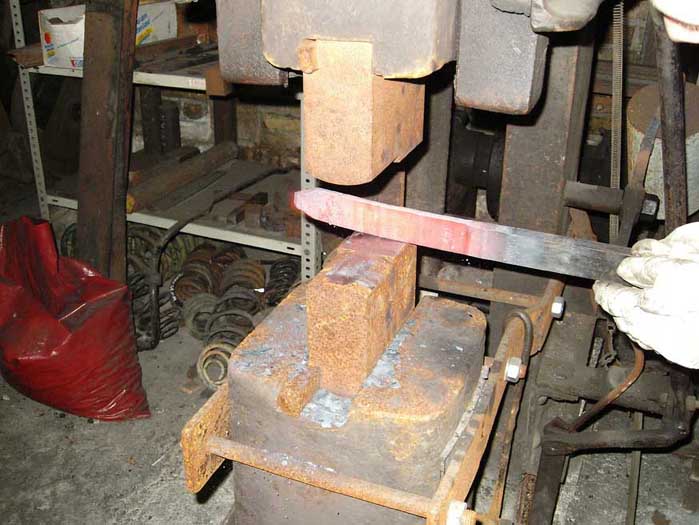
1060 steel (C60) pre-forging under the powerhammer...Thanks to Jens Eichler for the use of his power hammer
 Attachment: 67.65 KB
Attachment: 67.65 KB
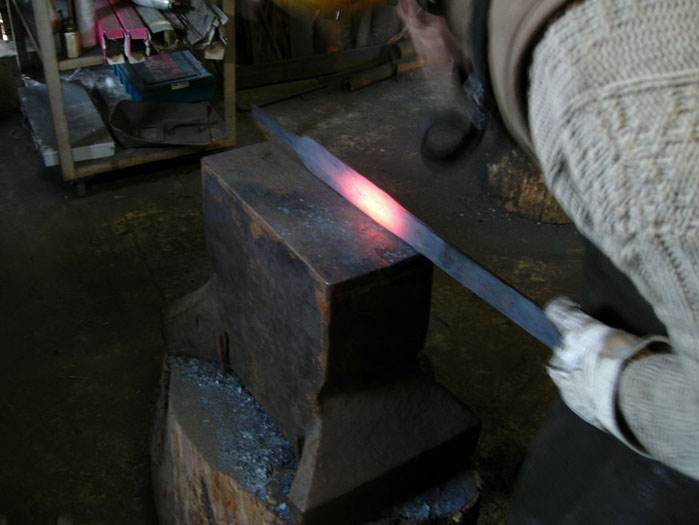
Forging the shape and the edges
 Attachment: 64.85 KB
Attachment: 64.85 KB
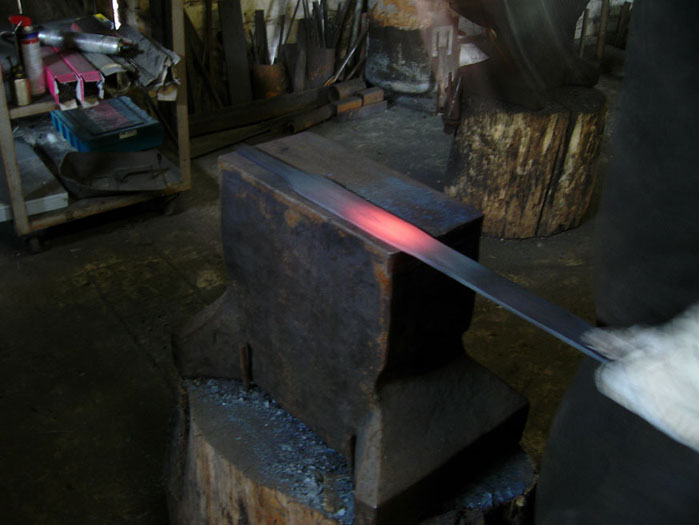
 Attachment: 79.59 KB
Attachment: 79.59 KB
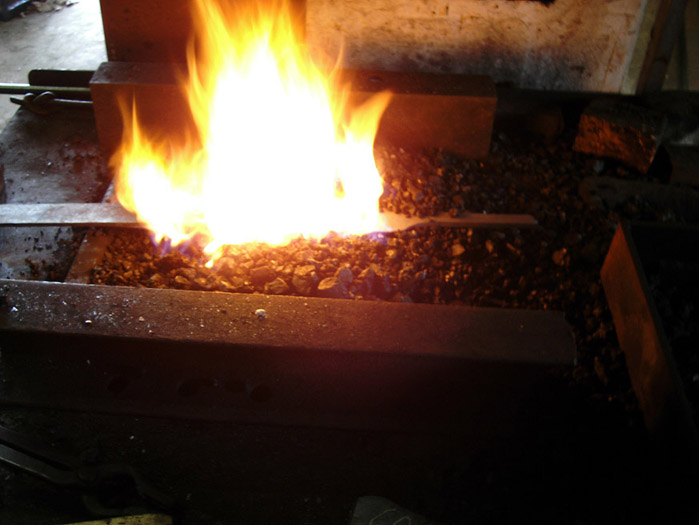
 Attachment: 69.7 KB
Attachment: 69.7 KB
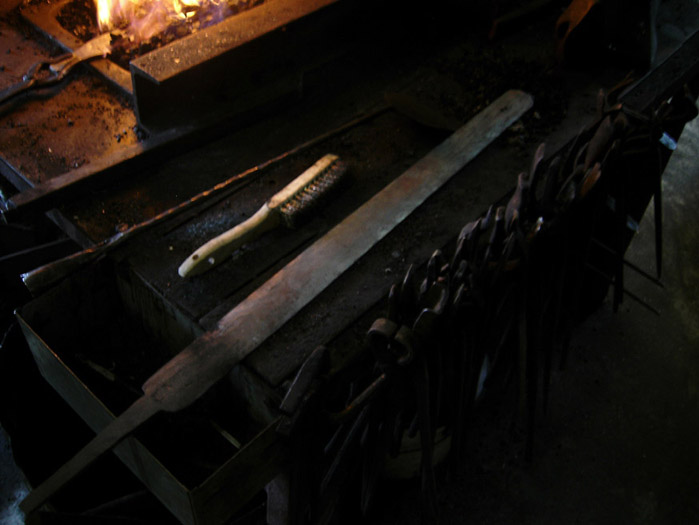
 Attachment: 77.33 KB
Attachment: 77.33 KB

after sanding it is heat treated in the forge, this process of heating the blade up...
 Attachment: 61.18 KB
Attachment: 61.18 KB
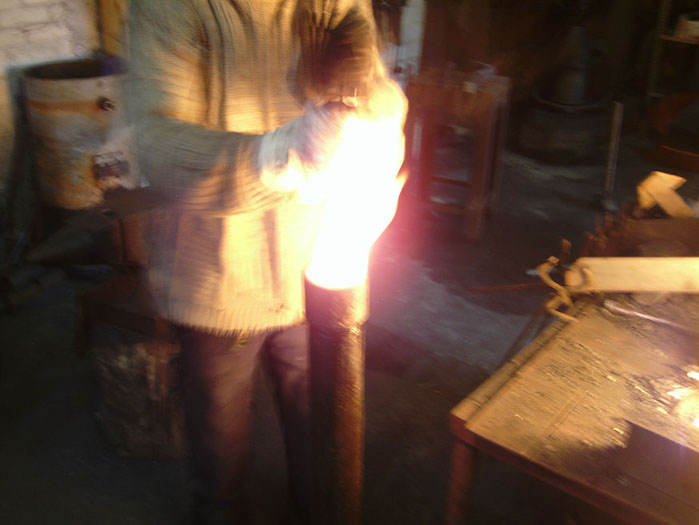
...took more than 30 minutes of moving it for- and backwards through the fire, the quench-medium is vegetabile oil
 Attachment: 55.25 KB
Attachment: 55.25 KB
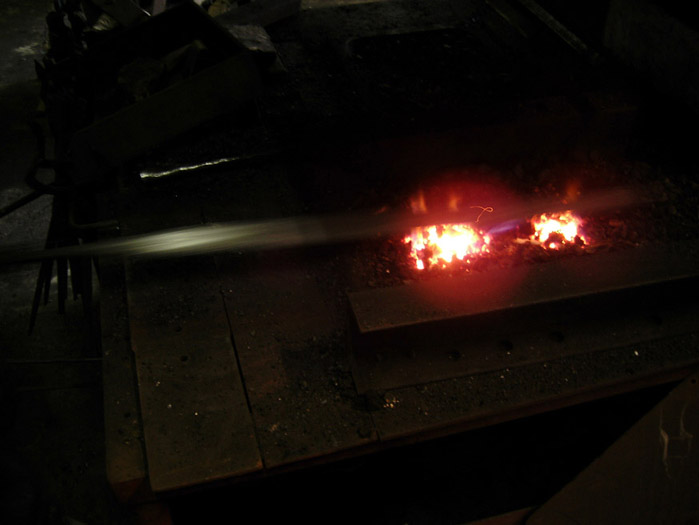
before tempering the blade had to be re-straightened from bending, this had to be done inner a few minutes. If done it too long, it would have broken.
Part one:

1060 steel (C60) pre-forging under the powerhammer...Thanks to Jens Eichler for the use of his power hammer

Forging the shape and the edges




after sanding it is heat treated in the forge, this process of heating the blade up...

...took more than 30 minutes of moving it for- and backwards through the fire, the quench-medium is vegetabile oil

before tempering the blade had to be re-straightened from bending, this had to be done inner a few minutes. If done it too long, it would have broken.
Last edited by Christian Böhling on Fri 09 Apr, 2010 6:41 am; edited 5 times in total
This is part two:
--------------------------------------------------------------------------------------------------------------------------------------------------------------
 Attachment: 53.78 KB
Attachment: 53.78 KB
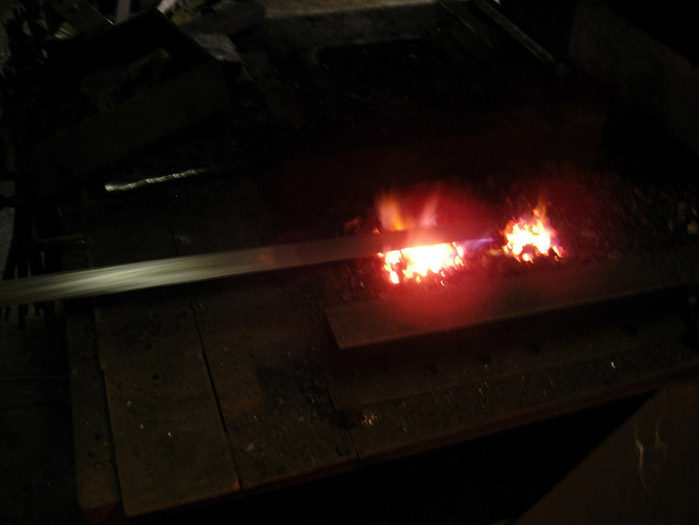
after another sanding it is heated again in the flames of the forge-fire to temper
 Attachment: 56.32 KB
Attachment: 56.32 KB
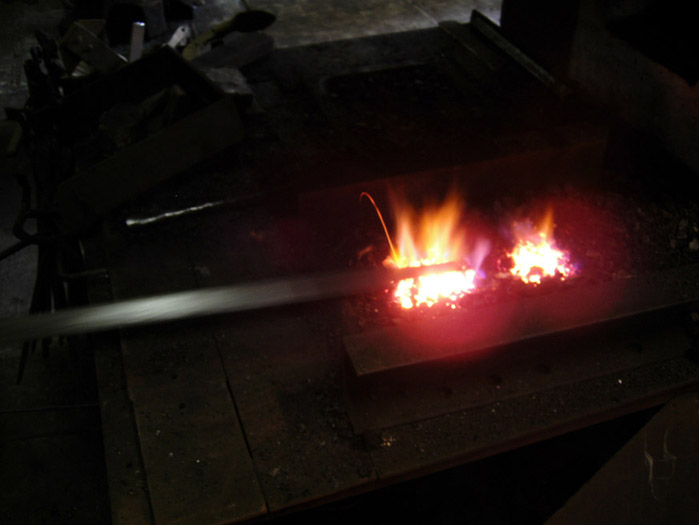
 Attachment: 95.3 KB
Attachment: 95.3 KB
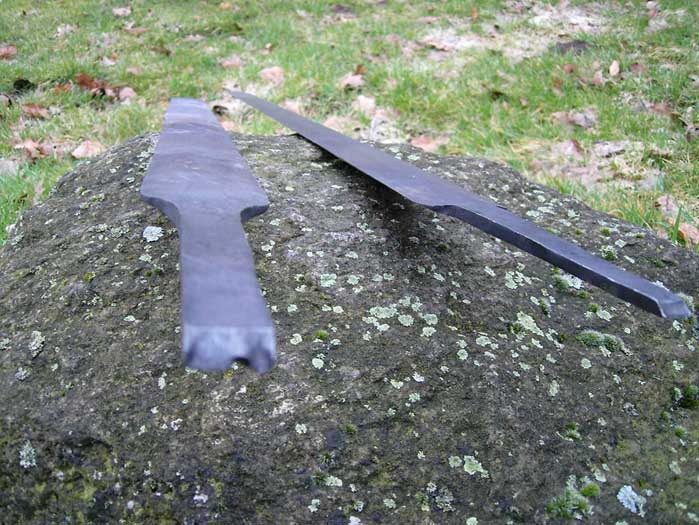
born in the Fire....
 Attachment: 98.77 KB
Attachment: 98.77 KB
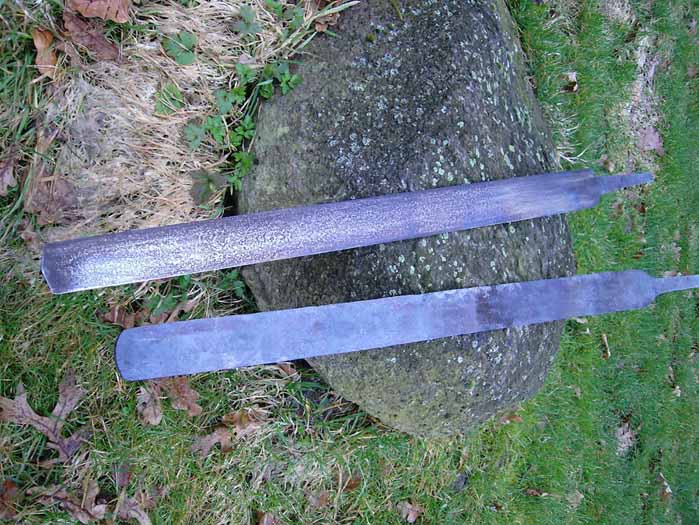
...will hopefully be still alive when we all are gone...
 Attachment: 100.58 KB
Attachment: 100.58 KB
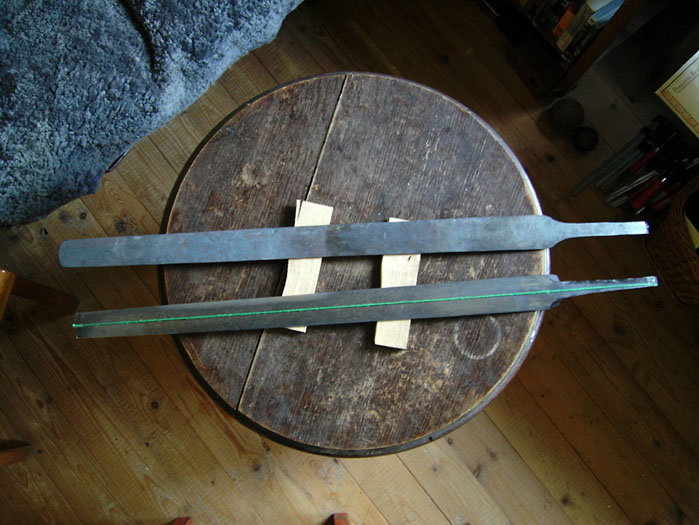
final shaping of blade geometry
 Attachment: 98.81 KB
Attachment: 98.81 KB
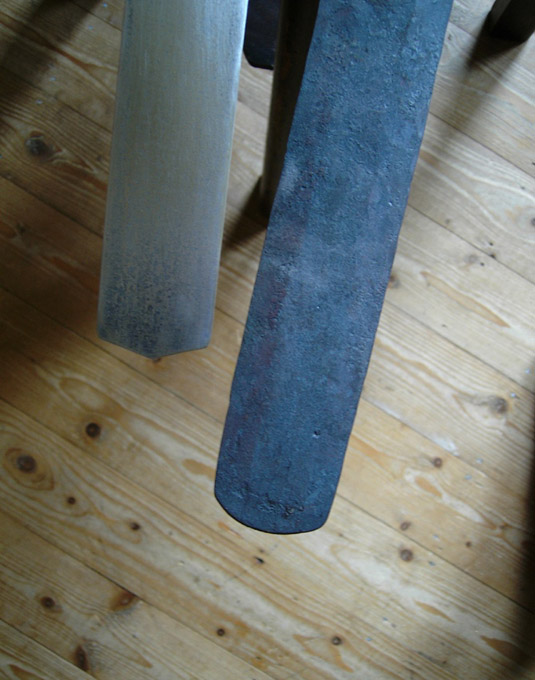
 Attachment: 93.04 KB
Attachment: 93.04 KB
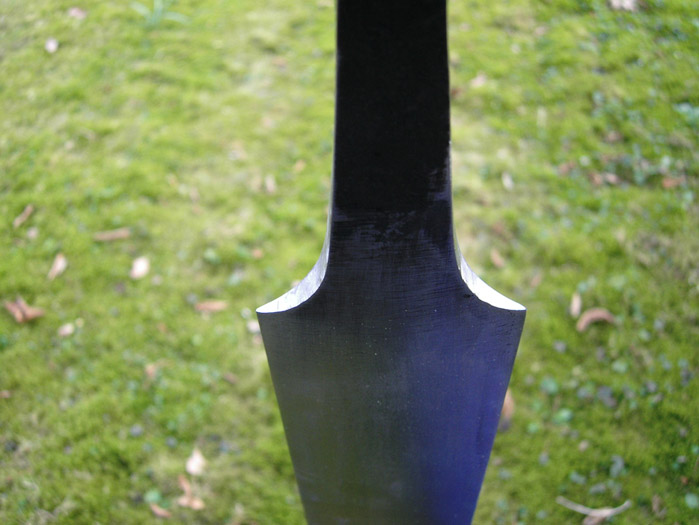
 Attachment: 91.27 KB
Attachment: 91.27 KB
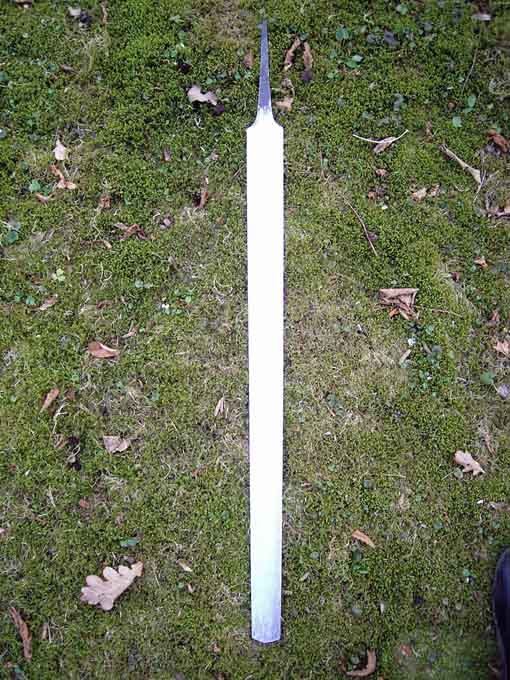
--------------------------------------------------------------------------------------------------------------------------------------------------------------

after another sanding it is heated again in the flames of the forge-fire to temper


born in the Fire....

...will hopefully be still alive when we all are gone...

final shaping of blade geometry



Last edited by Christian Böhling on Fri 09 Apr, 2010 6:43 am; edited 3 times in total
this is part three:
-------------------------------------------------------------------------------------------------------------------------------------------------------------------------
 Attachment: 40.19 KB
Attachment: 40.19 KB

original iron scabbard for this type of sword
 Attachment: 97.98 KB
Attachment: 97.98 KB
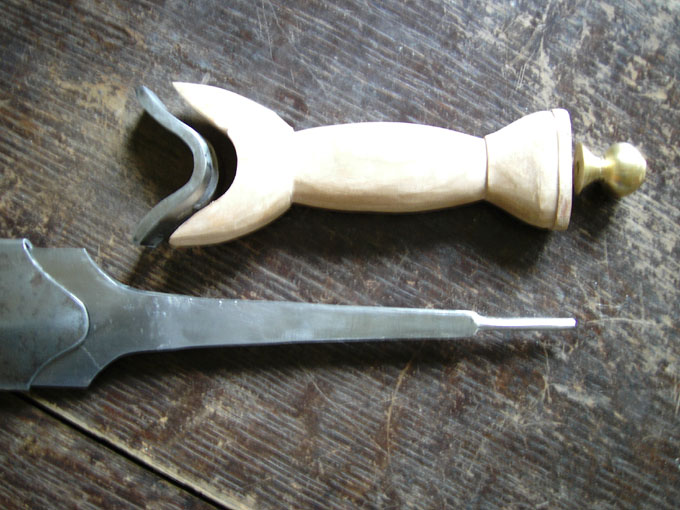
 Attachment: 103.64 KB
Attachment: 103.64 KB
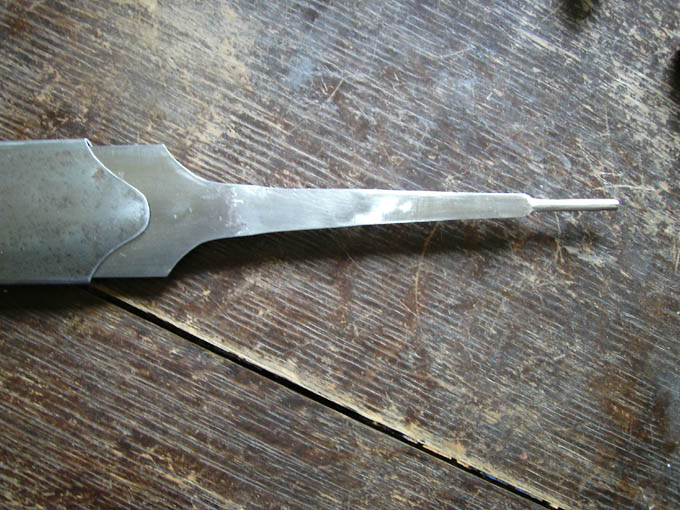
 Attachment: 103.72 KB
Attachment: 103.72 KB
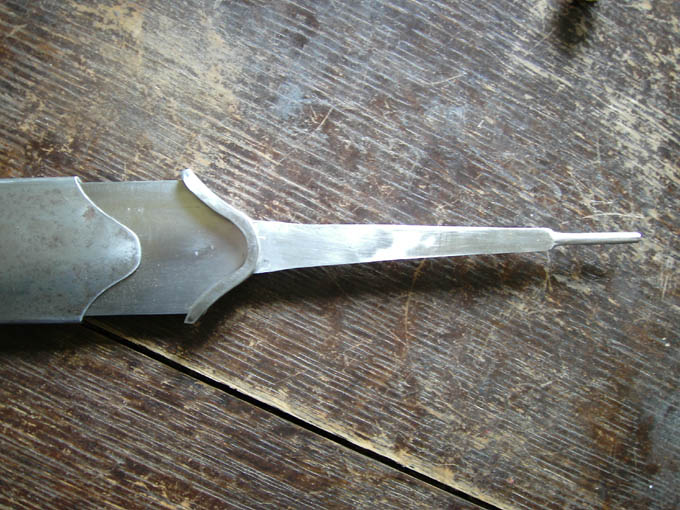
 Attachment: 93.57 KB
Attachment: 93.57 KB
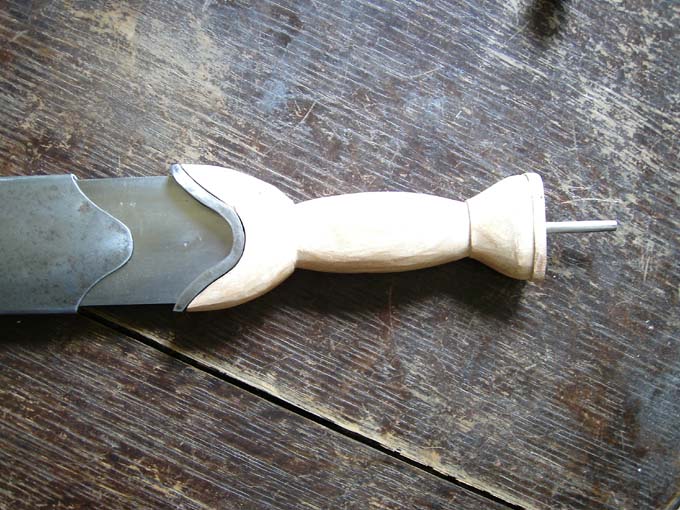
 Attachment: 82.98 KB
Attachment: 82.98 KB
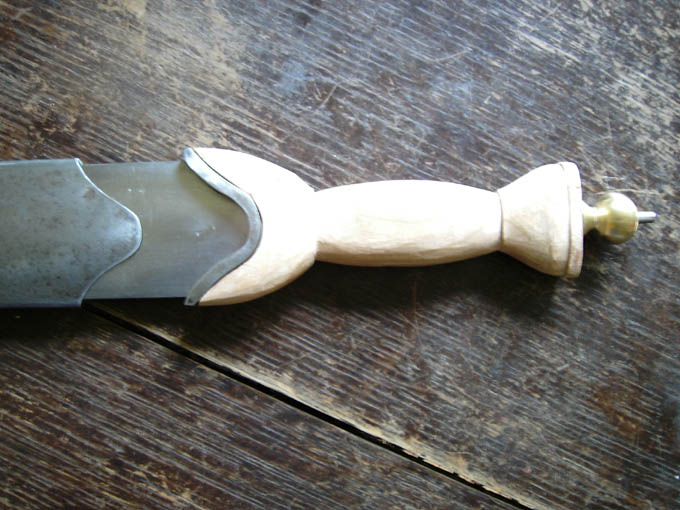
 Attachment: 90.48 KB
Attachment: 90.48 KB
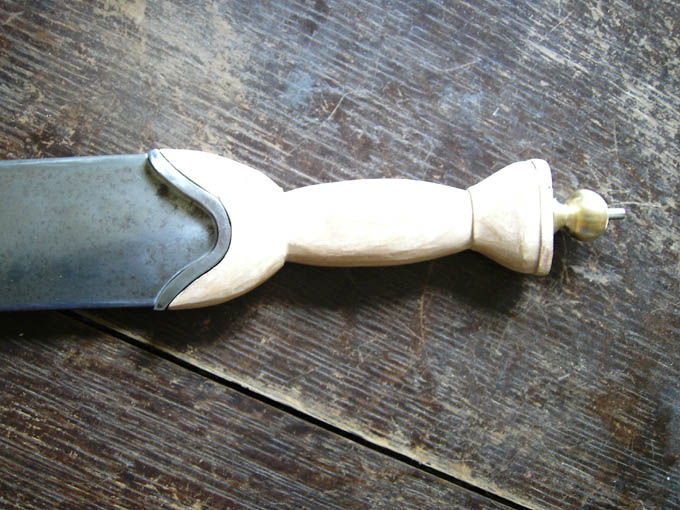
 Attachment: 98.41 KB
Attachment: 98.41 KB
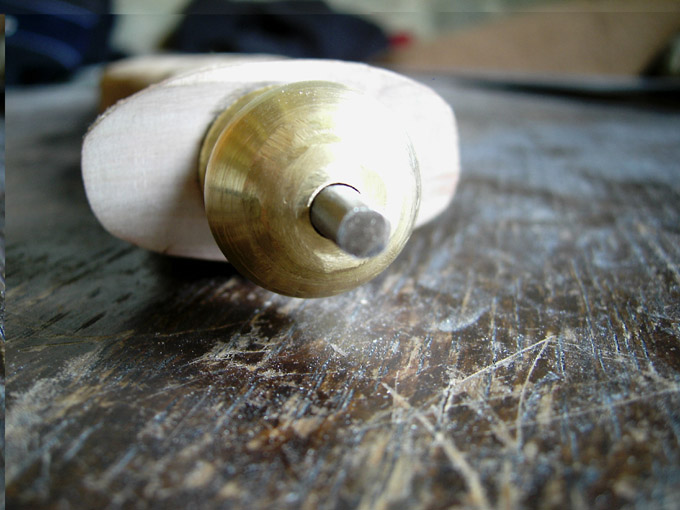
-------------------------------------------------------------------------------------------------------------------------------------------------------------------------

original iron scabbard for this type of sword







Last edited by Christian Böhling on Fri 09 Apr, 2010 4:23 am; edited 2 times in total
this is part four:
-----------------------------------------------------------------------------------------------------------------------------------------------------------------------
To be continued...
 Attachment: 85.27 KB
Attachment: 85.27 KB
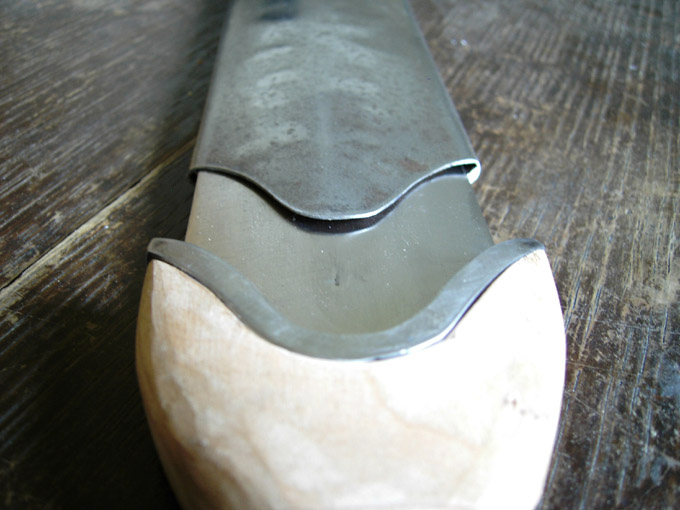
 Attachment: 89.94 KB
Attachment: 89.94 KB
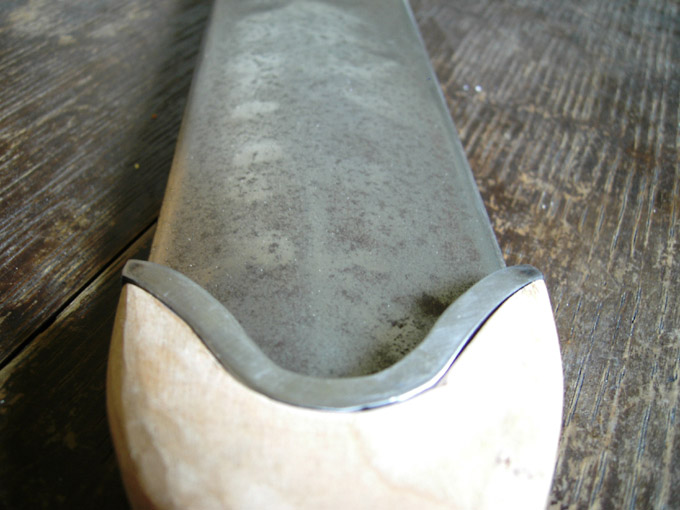
 Attachment: 103.14 KB
Attachment: 103.14 KB
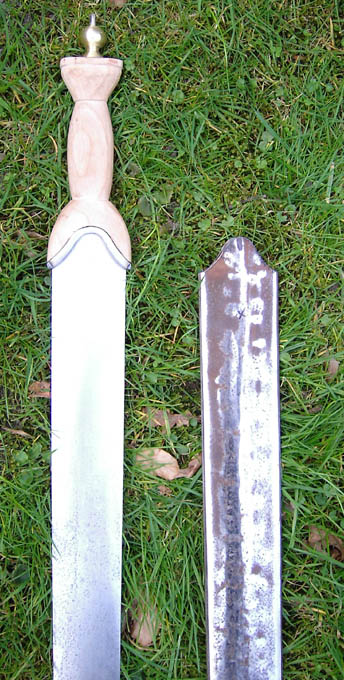
unfinished....
-----------------------------------------------------------------------------------------------------------------------------------------------------------------------
To be continued...



unfinished....
Great work of course! I appreciate the step by step pics, Christian. We can visualize the processes involved in creating these replicas and find inspiration in them and the history they represent. For those of us watching this thread the time delay is not an issue (for me I should say) since we get an email notification of the next post.
Good work Christian!
Not common to see these shortish, blunt ended swords reproduced. It shall be a beautiful sword when it is done.
I love that anvil you have. Would not mind such a piece myself :-)
Hopefully I will get opportunity to make a germanic/celtic blade of late 1st C BC/ early 1st C AD soon. I will try to take photos and add to this thread.
Looking forward to see your sword take final shape.
Not common to see these shortish, blunt ended swords reproduced. It shall be a beautiful sword when it is done.
I love that anvil you have. Would not mind such a piece myself :-)
Hopefully I will get opportunity to make a germanic/celtic blade of late 1st C BC/ early 1st C AD soon. I will try to take photos and add to this thread.
Looking forward to see your sword take final shape.
| Peter Johnsson wrote: |
|
I love that anvil you have. Would not mind such a piece myself :-) |
I would not mind myself! :) I have got four anvils, but this is not mine, it is Jens Eichler´s, think he has got it from Markus Balbach. Since he owns a few power hammers, we did this job in his forge. The forge-workshop I normally work in is a museum-forge without those great opportunities... to have done this job there would have meant to forge the steel bar by hand to the full lenght using too many heats for this steel. And also Jens has more skill in heat-treating than me...So we can call this project a partnership-project.
Yes, I hope to see your celtic-germanic sword to be done soon, maybe also with a "making-of"? It would be interesting to compare!
Thanks for sharing those pics christian, that a fine looking sword. I'm looking forward to seeing more from you in the future.
That is the finish germanic late LaTéne-periode sword, based on a find in Nienbüttel at the Elbe river in Germany.
Blade lenght: 75 cm.
weight of the sword: ca. 1000 gr.
Hope you like it.....
 Attachment: 90.3 KB
Attachment: 90.3 KB

 Attachment: 106.39 KB
Attachment: 106.39 KB

 Attachment: 106.52 KB
Attachment: 106.52 KB
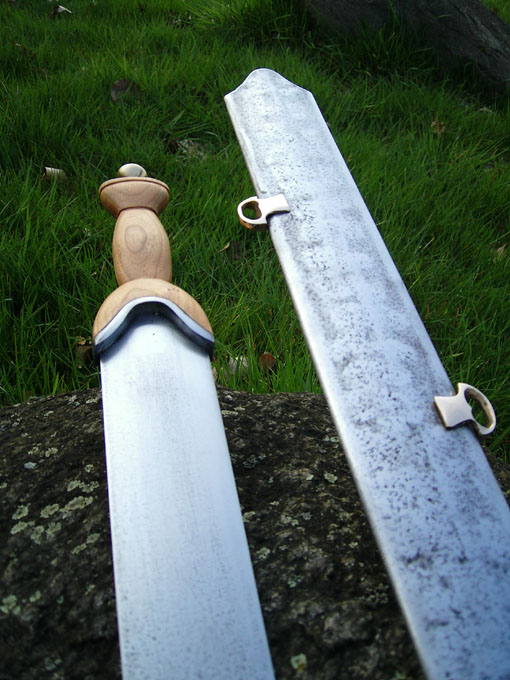
 Attachment: 94.73 KB
Attachment: 94.73 KB
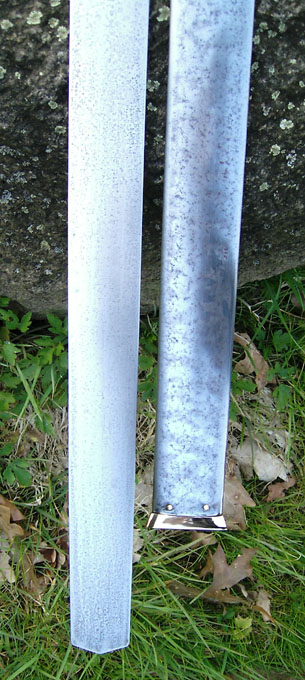
 Attachment: 103.62 KB
Attachment: 103.62 KB
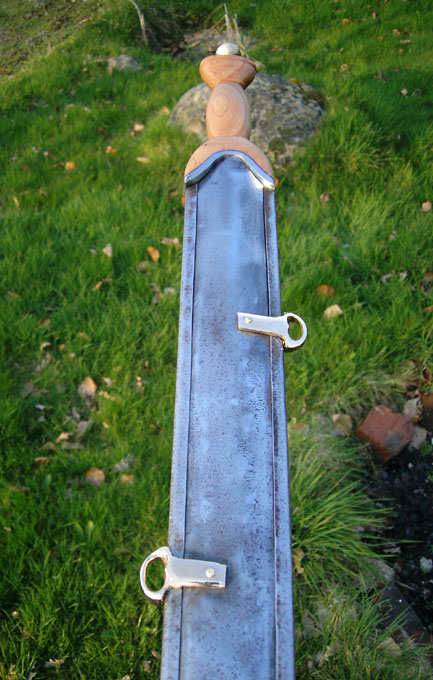
 Attachment: 106.05 KB
Attachment: 106.05 KB

Blade lenght: 75 cm.
weight of the sword: ca. 1000 gr.
Hope you like it.....






Last edited by Christian Böhling on Tue 13 Apr, 2010 12:39 pm; edited 1 time in total
WOW Christian, let me be the first to say that is some fantastic work :D
Page 7 of 8
You cannot post new topics in this forumYou cannot reply to topics in this forum
You cannot edit your posts in this forum
You cannot delete your posts in this forum
You cannot vote in polls in this forum
You cannot attach files in this forum
You can download files in this forum
All contents © Copyright 2003-2006 myArmoury.com — All rights reserved
Discussion forums powered by phpBB © The phpBB Group
Switch to the Full-featured Version of the forum
Discussion forums powered by phpBB © The phpBB Group
Switch to the Full-featured Version of the forum